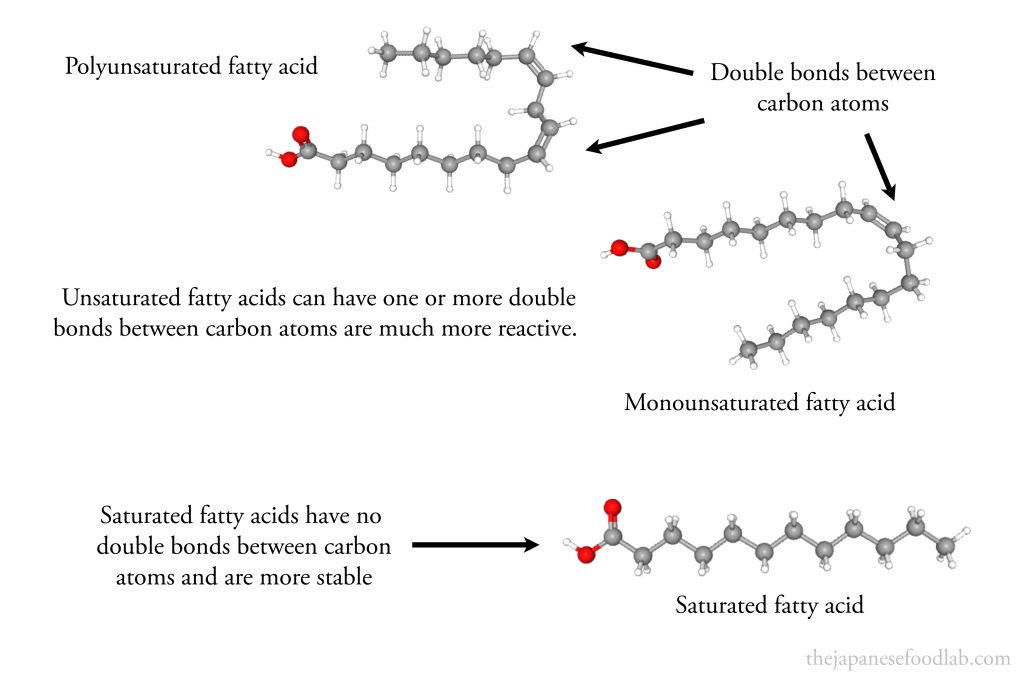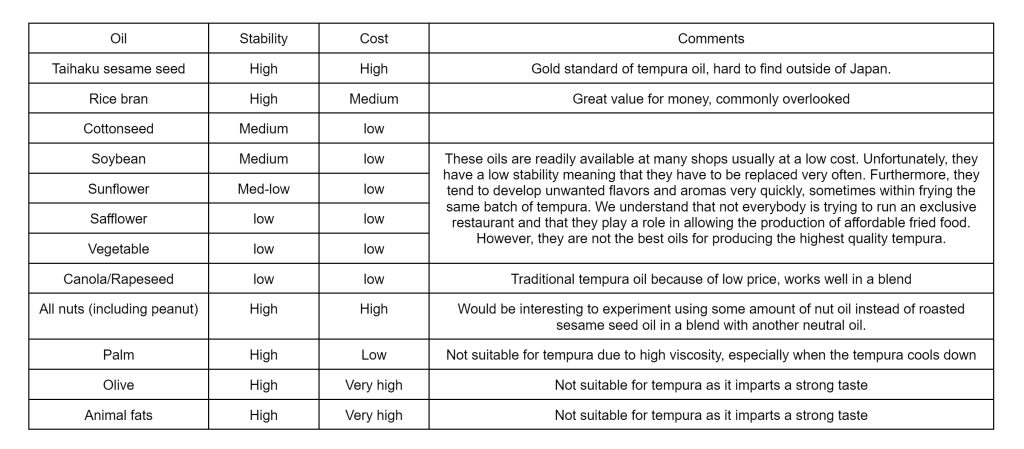This article is part of our series on tempura. We’ve also written about the science of tempura oil and traditional tempura oils which covers the life cycle of the oil and how it impacts flavor.
When learning about deep frying, the choice of oil is often overlooked as everyone focuses on the preparation and selection of ingredients. However, in the same way that the choice of blanching liquid, be it salted water or chicken stock, has an impact on the overall flavor of the ingredients, the type of oil used to fry food can impact the mouthfeel and taste of your tempura. Furthermore, your choice of oil also affects its reusability, which in turn can impact running costs.

Oil’s impact on flavor and texture
The majority of ingredients fried as tempura are either vegetables or seafood. It’s only recently that frying thin cutlets of pork or pieces of wagyu beef as tempura has become fashionable. As such, tempura is never fried using animal fats such as lard, clarified butter or shortening, as it would impart strong meaty flavors (these can be desirable, for example when frying tonkatsu).
To allow the natural taste of ingredients to be accentuated in your tempura, you’ll want to stick to neutral flavored oils such as vegetable oil, sunflower seed oil or canola oil. Using the same logic, olive oil, peanut oil and coconut oil are never used as they also impart flavors in your tempura.
The thickness, or more accurately the viscosity of your oil also matters as it affects how much oil clings to your tempura when served. We have found that oil with a high viscosity gives tempura a more oily and rich mouthfeel which usually can cause an almost greasy aftertaste. To circumvent this, it’s possible to blend different oils together, to achieve your desired texture and characteristics.
We have found palm oil and some brands of roasted sesame seed oils to be too viscous for our liking, but it varies from country to country and ultimately you need to do a bit of experimentation based on locally available oils.
Oil’s impact on reusability and cost
As elaborated on in our article on the science of tempura frying oil, frying oil has a finite lifespan before it starts to impart unwanted flavors and smells in your tempura.
As oil is heated up over and over again, several chemical changes start to occur.
- The oil starts to emulsify with water, creating bubbles on the surface of the oil
- The fats in the oil start to break down, releasing free fatty acids and other compounds that produce rancid or off flavors.
- Polymerization and oxidation also occurs, forming undesirable compounds such as resins and acrolein that also contribute to unwanted smells and flavors.
- The production of acrylamides which are detrimental to health.
Once these chemical changes have occurred to a discernible degree, you have no choice but to change to a new batch of frying oil.
As changing oil frequently can increase the cost associated with deep frying, you’ll want to choose a long lasting oil but also one that produces the style of tempura you wish to make.
Does the smoke point of oil indicate stability?
When choosing oil for deep frying, people often talk about the importance of an oil with a high smoke point as it is more stable and can be reused more. The smoke point of an oil is the temperature at which an oil starts to produce visible smoke when heated while the flash point is the temperature at which the oil will catch fire when exposed to a flame or spark. Unfortunately, this is one of the biggest kitchen misconceptions. In reality, the smoke point of an oil does not tell you anything about its ability to resist chemical change.
This intuitively makes sense as the temperatures used for deep frying are nowhere close to the smoke point of most common deep frying oil. Instead, an oil’s stability and reusability depend on its resistance to chemical changes, such as oxidation and polymerization, which can occur even below the smoke point. These changes can affect the oil’s flavor, nutritional quality, and safety. So, an oil may have a high smoke point but still become less suitable for reuse over time.
What are the factors that affect oil stability?
Antioxidants
Given that oxidation is one of the major chemical changes that degrades the quality of oil, it comes to no surprise that the higher amount of antioxidants naturally present in the oil, the more stable it is. Unfortunately the oil with the highest amount of antioxidants, olive oil, is not suitable for frying tempura due to the flavor it imparts.
Refinement
Unlucky for us, most of the sources of oils we use are obtained with a high level of processing. With the exception of a few oils such as olive, avocado, sesame and flax seed oil which can be obtained from mechanical pressing, most other oils require a high amount of refinement to render them edible. Example processes include:
- Degumming: The crude oil obtained from crushing contains impurities like phospholipids and other gums. Degumming involves treating the oil with water or acid to remove these impurities.
- Neutralization: The oil is treated with an alkali solution (such as sodium hydroxide) to neutralize free fatty acids, reducing acidity and improving the oil’s quality.
- Bleaching: The oil is passed through a bleaching clay or activated carbon to remove pigments, traces of metals, and any remaining impurities.
- Deodorization: This step involves heating the oil to remove any odors or flavors that might affect its quality. It helps in creating a neutral-tasting oil.
- Winterization: In some cases, especially for oils that might solidify at lower temperatures, a winterization process is used to remove waxes and prevent clouding or solidification at cold temperatures.
While these processes produce a neutral oil perfect for tempura, it can remove any naturally present antioxidants in the oil and reduce its stability. It is one of the reasons vegetable oil and canola oil have such a low stability.

Type of fat
When looking at oil from a molecular level, you’ll find that different oils are made from various different types of fatty acids. Fatty acids are composed of a long hydrocarbon chain with a carboxyl group at one end. The general structure of a fatty acid is as follows:
- Hydrocarbon Chain: This is a chain of carbon and hydrogen atoms. It can vary in length from a few carbons to many (commonly between 4 to 28 carbons in length in biological systems).
- Carboxyl Group (COOH): This is a functional group at one end of the hydrocarbon chain, consisting of a carbon atom doubly bonded to an oxygen atom and single-bonded to a hydroxyl group (OH). This carboxyl group gives fatty acids their acidic properties.
The chain can be saturated (having only single bonds between carbon atoms), monounsaturated (containing one double bond between carbon atoms, or polyunsaturated (more than double bonds between carbon atoms). Without going into too much detail around the chemistry, saturated fatty acids with only single bonds between carbon atoms are much more stable and less chemically reactive than unsaturated fatty acids, with the least stable being polyunsaturated fatty acids.
You can easily tell which oils and fats contain saturated fatty acids as they tend to be solid at room temperature. For example, beef drippings, lard, duck fat, coconut oil and butter. Meanwhile, monounsaturated fats tend to be the high value oils due to their health benefits such as olive oil and most nut oils. Lastly, most cheap and easily available oils used for deep frying are polyunsaturated.
The best deep frying oil for tempura
Based on all the information above, your choice of deep frying oil will ultimately be a trade off between cost, availability, stability and texture. To help with the decision process, we’ve compiled a table below which summarizes our opinion on the pros and cons of different deep frying oils specific to tempura.

Adding sesame seed oil to tempura
While not immediately obvious to most people, the taste of roasted sesame seeds is inextricably tied to tempura. It is almost always there in the backdrop, gently supporting and rounding off the taste of every ingredient. To learn more, read our other article to learn more about traditional tempura oil.